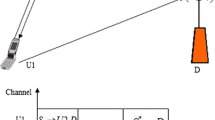Abstract
A time diversity automatic repeat-request (ARQ) scheme is investigated for slotted random access direct-sequence code-division multiaccess (DS/CDMA ALOHA) wireless packet radio networks on multipath Rayleigh fading channels. The receiver retains and processes all the retransmissions of a single data block (packet) using predetection diversity combining, instead of discarding those which are detected in error. This effectively improves the system throughput and delay characteristics especially at small values of signal-to-noise ratio (SNR) per bit. A simple and practical selection combining rule is proposed, which lends itself to a low-complexity receiver structure and specifically suitable for high data rate transmissions. Owing to the stochastic nature of the multiple access interference, the new maximum output selection diversity (MO/SD) system yields superior performance in comparison to the traditional maximum SNR selection diversity (SNR/SD) model. The bit error rate performance, throughput and the average number of transmissions required to transmit a packet successfully with and without forward error correction (FEC) are evaluated. Numerical results reveal that the proposed adaptive retransmission diversity with packet combining provides a considerable advantage over the conventional slotted DS/CDMA ALOHA without incurring a substantial penalty in terms of cost or complexity.
Similar content being viewed by others
References
M.B. Pursley, “The Role of Spread Spectrum in Packet Radio Network”, in Proc.IEEE, Vol. 75, January 1987, pp 116–134.
L.B. Milstein, D.L. Schilling, R.L. Pickholtz, V. Erceg, M. Kullback, E.G. Kanterakis, D.S. Fishman, W.H. Biederman and D.C. Salerno, “On the Feasibility of a CDMA Overlay for Personal Communications Networks”, IEEE J.Selected Areas on Commun., Vol. 10, pp 655–668, 1992.
K. Joseph and D. Raychaudhuri, “Performance Evaluation of Cellular Packet CDMA Networks with Transmit Power Constraints”, in Proc.IEEE Int.Conf.on Communications (ICC'91), June 1991, pp 1614–1620.
R.D.J. van Nee, R.N. van Wolfswinkel and R. Prasad, “Slotted ALOHA and CDMA Techniques for Land-Mobile Satellite Personal Communications”, IEEE J.Selected Areas on Commun., Vol. 13, pp 382–388, 1995.
V.K. Bhargava, “High Rate Data Transmission in Mobile and Personal Communications”, in Proc.IEEE PIMRC, The Hague, The Netherlands, September 1994, pp 1106–1113.
W.C. Jakes, Microwave Mobile Communications, American Telephone and Telegraph Company, 1974 (Reissued by IEEE Press, Piscataway, NJ, 1993).
D. Chase, “Code Combining - A Maximum-Likelihood Decoding Approach for Combining an Arbitrary Number of Noisy Packets”, IEEE Trans.Commun., Vol. 33, pp 385–393, 1985.
S. Kallel, “Analysis of a Type II Hybrid ARQ Scheme with Code Combining”, IEEE Trans.Commun., Vol. 38, pp 1133–1137, 1990.
M. Kavehrad and P.J. McLane, “Performance of Low-Complexity Channel Coding and Diversity for Indoor Wireless Communications”, AT&T Tech.Journal, Vol. 64, pp 1927–1965, 1985.
M.B. Pursley, “Performance Evaluation for Phase-Coded Spread-Spectrum Multiple Access Communications - Part-I: System Analysis”, IEEE Trans.Commun., Vol. 25, pp 795–799, 1977.
M.B. Pursley and Dilip V. Sarwate, “Performance Evaluation for Phase-Coded Spread-Spectrum Multiple Access Communications - Part-II: Code Sequence Analysis”, IEEE Trans.Commun., Vol. 25, pp 800–804, 1977.
J.G. Proakis, Digital Communications, (Third Edition), McGraw-Hill: NY, 1995.
E. Geraniotis and M.B. Pursley, “Performance of Coherent Direct-Sequence Spread-Spectrum Communications Over Specular Multipath Fading Channels”, IEEE Trans.Commun., Vol. 33, pp 502–508, 1985.
J.M. Holtzman, “A Simple, Accurate Method to Calculate Spread-Spectrum Multiple-Access Error Probabilities”, IEEE Trans.Commun., Vol. 40, pp 461–465, 1992.
R. Morrow and J. Lehnert, “Packet Throughput in Slotted ALOHA DS/SSMA Radio Systems with Random Signature Sequences”, IEEE Trans.Commun., Vol. 40, pp 1223–1230, 1992.
C. Trabelsi and A. Yongacoglu, “Bit Error Rate Performance for Asynchronous DS-CDMA over Multipath Fading Channels”, IEE Proc.Commun., Pt.F, Vol. 142, pp 307–314, 1995.
M. Kahvehrad and B. Ramamurthi, “Direct-Sequence Spread Spectrum with DPSK Modulation and Diversity for Indoor Wireless Communications”, IEEE Trans.Commun., Vol. 35, pp 224–236, 1987.
D. Devasirvatham, “Multipath Time Delay Spread in Digital Portable Radio Environment”, IEEE Commun. Mag., Vol. 25, pp 13–21, 1987.
T.S. Rappaport, “Indoor Radio Communications for Factories of the Future”, IEEE Commun.Mag., Vol. 27, pp. 15–24, 1989.
R. Bultitude, “Propagation Characteristics in Microcellular Urban Mobile Radio Channels at 910 MHz”, IEEE J.Selected Areas Commun., Vol. 7, pp 31–39, 1989.
A. Annamalai and V.K. Bhargava, “Performance of Selection Combining Time-Diversity ARQ in Slotted DS/CDMA Wireless Packet Radio Networks”, in Proc.Int.Symposium on Information Theory and Its Applications 1996, Victoria, Canada, 17- 20 September 1996, pp 460–463.
W. Press, S. Teukolsky, W. Vetterling and B. Flannery, Numerical Recipes in C: The Art of Scientific Computing, (Second Edition), Cambridge University Press: Cambridge, 1992.
D. Raychaudhuri, “Performance Analysis of Random Access Packet-Switched Code Division Multiple Access Systems”, IEEE Trans.Commun., Vol. 29, pp 895–901, 1981.
M.B. Pursley, “Frequency-Hop Transmission for Satellite Packet Switching and Terrestrial Packet Radio Networks”, IEEE Trans.Information Theory, Vol. 32, pp 652–667, 1986.
A. Bigloo, T.A. Gulliver and V.K. Bhargava, “Slotted DS/SSMA ALOHA with Packet Combining in a Rayleigh Fading Channel”, in Proc.IEEE Int.Conf.on Vehicular Technology 1996, May 1996, pp 1710–1714.
E. Geraniotis, “Direct-Sequence Spread-Spectrum Multiple-Access Communications Over Nonselective and Frequency-Selective Rician Fading Channels”, IEEE Trans.Commun., Vol. 34, pp 756–764, 1986.
G. Chyi, J.G. Proakis and C.M. Keller, “On the Symbol Error Probability of Maximum Selection Diversity Reception Schemes over a Rayleigh Fading Channel”, IEEE Trans.Commun., Vol. 37, pp 79–83, 1989.
E.A. Neasmith and N.C. Beaulieu, “A New Look at Selection Diversity”, in Proc.WIRELESS'96, July 1996, pp. 191–206.
Author information
Authors and Affiliations
Rights and permissions
About this article
Cite this article
Annamalai, A., Bhargava, V.K. Adaptive Retransmission Diversity with Packet Combining for Slotted DS/CDMA Packet Radio Networks. Wireless Personal Communications 11, 269–291 (1999). https://doi.org/10.1023/A:1018650323900
Issue Date:
DOI: https://doi.org/10.1023/A:1018650323900




